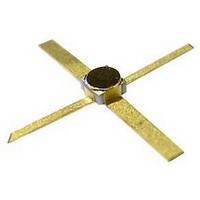ATF-36077-TR1 Avago Technologies US Inc., ATF-36077-TR1 Datasheet

ATF-36077-TR1
Specifications of ATF-36077-TR1
Available stocks
Related parts for ATF-36077-TR1
ATF-36077-TR1 Summary of contents
Page 1
... Properly matched, this transistor will provide typical 12 GHz noise figures of 0.5 dB, or typical 4 GHz noise figures of 0.3 dB. Additionally, the ATF-36077 has very low noise resistance, reducing the sensitivity of noise performance to variations in input impedance match, making the design of broadband low noise amplifiers much easier ...
Page 2
... ATF-36077 Absolute Maximum Ratings Symbol Parameter V Drain – Source Voltage DS V Gate – Source Voltage GS V Gate-Drain Voltage GD I Drain Current D P Total Power Dissipation Input Power in max T Channel Temperature ch T Storage Temperature STG ATF-36077 Electrical Specifications 25° Ω 1 Symbol Parameters and Test Conditions ...
Page 3
... ATF-36077 Typical “Off ” Scattering Parameters, Common Source Ω 1 Freq GHz Mag. Ang. 11.0 0.96 -139 12.0 0.95 -152 13.0 0.94 -166 ...
Page 4
... ATF-36077 Typical Noise Parameters, Common Source Ω 1 Freq. F [1] min GHz dB 1 0.30 2 0.30 4 0.30 6 0.30 8 0.37 10 0.44 12 0.50 14 0.56 16 0.61 18 0.65 Note: 1. The F values at 2,4, and 6 GHz have been adjusted to reflect expected circuit losses that min will be encountered when matching to the optimum reflection coefficient (Γ ...












